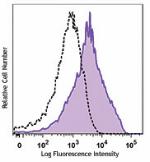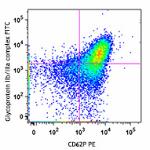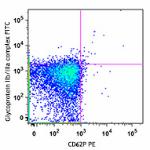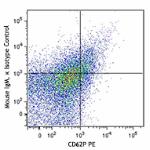- Clone
- PAC-1 (See other available formats)
- Regulatory Status
- RUO
- Other Names
- gpIIb/IIIa complex, integrin αIIbβ3
- Isotype
- Mouse IgM, κ
- Ave. Rating
- Submit a Review
- Product Citations
- publications

-

ADP-activated human platelets (filled histogram) or resting platelets (open histogram) were stained with purified anti-human glycoprotein IIb/IIIa complex (clone PAC-1), followed by anti-mouse IgM FITC.
| Cat # | Size | Price | Quantity Check Availability | Save | ||
|---|---|---|---|---|---|---|
| 362802 | 100 µg | 229 CHF | ||||
The gpIIb/IIIa complex, also known as integrin αIIbβ3, is expressed by megakaryocytes and platelets. It undergoes conformational changes upon activation by substances, such as ADP, thrombin, and TXA2, which subsequently reveals a ligand binding site that is specific for fibrinogen, von Willebrand factor (vWF), fibronectin, and vitronectin. This conformational change is crucial for platelet-platelet adhesion. Ligand bound gpIIb/IIIa complex promotes platelet aggregation. This complex plays an important role in hemostasis and is a target for developing therapeutic antibodies in immune thrombocytopenia.
Product DetailsProduct Details
- Verified Reactivity
- Human
- Antibody Type
- Monoclonal
- Host Species
- Mouse
- Immunogen
- Human platelets
- Formulation
- Phosphate-buffered solution, pH 7.2, containing 0.09% sodium azide.
- Preparation
- The antibody was purified by affinity chromatography.
- Concentration
- 0.5 mg/ml
- Storage & Handling
- The antibody solution should be stored undiluted between 2°C and 8°C.
- Application
-
FC - Quality tested
IP, WB - Reported in the literature, not verified in house - Recommended Usage
-
Each lot of this antibody is quality control tested by immunofluorescent staining with flow cytometric analysis. For flow cytometric staining, the suggested use of this reagent is ≤2.0 µg per million cells in 100 µl volume. It is recommended that the reagent be titrated for optimal performance for each application.
- Application Notes
-
Additional reported applications (for the relevant formats of this clone) include: immunoprecipitation1,2, Western blotting2 and in vitro blocking of platelet aggregation2.
The PAC-1 antibody reacts with activation-induced conformational epitope of the integrin aIIbß3. PAC-1 binding to fibrinogen is pH and Ca2+ dependent, and will not bind to platelets that have been fixed. We recommend staining in buffers free of Ethylenediaminetetraacetic acid (EDTA) at a pH of 6.5 or higher. Sodium citrate may be used as an anticoagulant for blood collection3.
-
Application References
(PubMed link indicates BioLegend citation) -
- Shattil SJ, et al. 1987. Blood. 70:307. (IP)
- Shattil SJ, et al. 1985. J. Biol. Chem. 260:11107. (Block, IP, WB)
- Shattil SJ, et al. 1986. Blood. 68: 1224-31.
- Product Citations
-
- RRID
-
AB_2563889 (BioLegend Cat. No. 362802)
Antigen Details
- Structure
- α/β transmembrane heterodimer of the ubiquitous integrin superfamily
- Distribution
-
Resting platelets; activated platelets express a conformationally modified complex that can bind fibrin
- Function
- Fibrinogen binding, platelet aggregation
- Ligand/Receptor
- Fibrinogen
- Cell Type
- Platelets
- Biology Area
- Cell Adhesion, Cell Biology, Immunology
- Molecular Family
- Adhesion Molecules, CD Molecules
- Antigen References
-
1. Hynes RO. 1992. Cell 69:11.
2. Shattil SJ, et al. 1985. J. Biol. Chem. 260:11107.
3. Ginsberg, et al. 1990. Blood 76:2017.
4. O’Toole TE, et al. 1991. Science 254:845.
5. Peterson JA, et al. 1998. Blood 92: 2053. - Gene ID
- 3674 View all products for this Gene ID 3690 View all products for this Gene ID
- UniProt
- View information about CD41 or CD61 on UniProt.org
Related Pages & Pathways
Pages
Related FAQs
Other Formats
View All CD41/CD61 Reagents Request Custom Conjugation| Description | Clone | Applications |
|---|---|---|
| Purified anti-human CD41/CD61 | PAC-1 | FC,IP,WB |
| FITC anti-human CD41/CD61 | PAC-1 | FC |
| Alexa Fluor® 647 anti-human CD41/CD61 | PAC-1 | FC |
Compare Data Across All Formats
This data display is provided for general comparisons between formats.
Your actual data may vary due to variations in samples, target cells, instruments and their settings, staining conditions, and other factors.
If you need assistance with selecting the best format contact our expert technical support team.
-
Purified anti-human CD41/CD61

ADP-activated human platelets (filled histogram) or resting ... -
FITC anti-human CD41/CD61

ADP activated human enriched platelets (top) or resting plat... 
-
Alexa Fluor® 647 anti-human CD41/CD61

ADP activated enriched human platelets (top) or resting plat... 
 Login / Register
Login / Register 









Follow Us